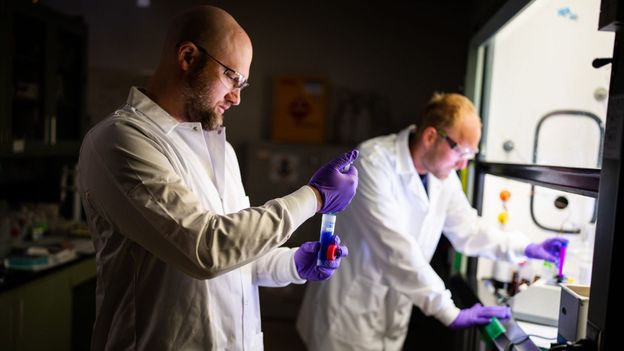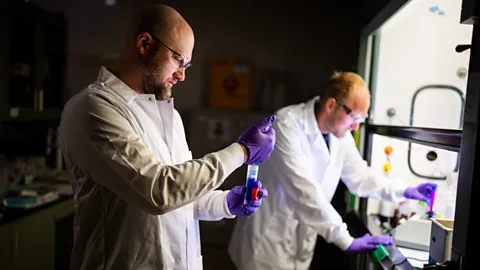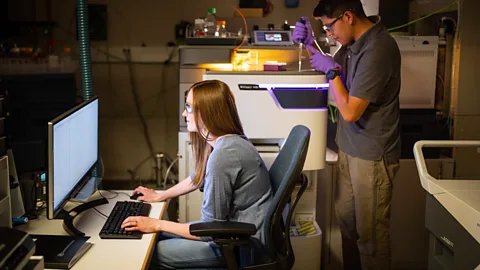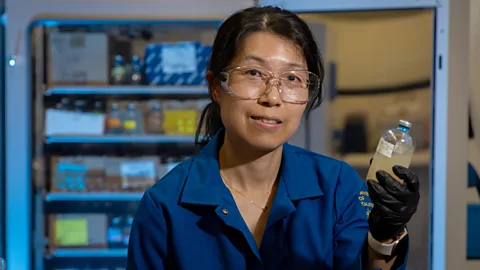
Can we take the ‘forever’ out of forever chemicals?
[ad_1]
 Craig Fritz
Craig FritzNicknamed “forever chemicals”, PFAS are ubiquitous. Now, scientists are looking to nature for ways to clean up the PFAS mess.
 Getty Images
Getty Images“I think all of this is fixable. It’s just a matter of cost,” says Ian Cousins, a professor of environmental chemistry at Stockholm University. “There are treatment technologies that work for legacy PFAS. You can, in principle, clean up a very contaminated site – if you have all the money in the world. But where’s the money going to come from? We need technologies that are low cost, low energy.”
US limits ‘forever chemicals’ in tap water
Now, scientists are developing new ways to clean up PFAS pollution and prevent further environmental contamination.
Commercially available water filters, as well as industrial scale filters for water treatment plants, tend to focus on removing heavy metals, pesticides and contaminants such as chlorine.
But, because PFAS include such a diverse group of chemical compounds, making filters that can remove them all is a huge challenge, says Andrew Knight, a chemist at US government-funded Sandia National Laboratories. He is working with a team of chemists and material scientists to design a filtration system able to capture a wide range of PFAS.
Different filters tend to be effective for different PFAS so Knight is investigating which materials and pore sizes give maximum adsorption of multiple PFAS compounds. Generally, more abundant organic matter sticks to filters first, he says, so placing a PFAS filter at a stage in the filtration system where organic matter is at a minimum could help target PFAS.
However, Knight warns there are too many unknowns right now: “The toxicology of these chemicals is not yet fully understood so we don’t really know which ones are the most toxic. We just know they’re everywhere and they shouldn’t be.”
Then there is the question of waste. If PFAS can be successfully filtered out of the water, you are left with waste material containing a high concentration of PFAS.
“Enabling some sort of degradation would be critical,” says Knight who notes that any new filtration economy needs to allow for customers to send contaminated filters away for proper disposal.
Cousins adds: “There are energy efficient ways to filter it, but at the moment there aren’t any energy efficient ways to destroy PFAS. There’s no magical solution available right now.”
 Craig Fritz
Craig FritzBeyond filtering out PFAS, some researchers are investigating more cost-effective and practical destruction technologies that break down PFAS without the need for high heat or intense pressure.
As the study author Haizhou Liu explains, trace levels of both long- and short-chain PFAS in groundwater are broken down. When the strong carbon-flourine bonds within all PFAS are split using this green chemistry, without heat or additional chemicals, fluoride is the only by-product – one that helps protect our teeth.
“Essentially, we’re converting a toxic chemical into a beneficial element,” says Liu who published a lab-scale study last year that destroyed PFAS in one litre (0.2 gallons) of contaminated water. “We have promising real water data that shows very high destruction.”
Liu is now building a pilot-scale system that will be able to process several gallons of water per minute. Within two years, he hopes to develop a UV reactor that can handle millions of gallons per day. And because UV light is already widely used as a disinfection method, Liu highlights that deep UV can be retrofitted into existing infrastructure at municipal water treatment plants using low-energy LED UV lamps. “To commercialise, the technology needs to be simple,” he adds.
 Stan Lim
Stan LimIn addition to water treatment, soil remediation is necessary at heavily contaminated sites. One strategy is to pump activated carbon into the soil that binds PFAS in situ to prevent leaks into groundwater – this has been done in Australia, for example, but there are no longterm studies of this yet. Another option is to dig out contaminated soil and clean it, using different washing methods, but the remaining water still has to be purified, either with filters or UV radiation.
Some academics are looking to nature for inspiration – and microbes could offer a biological solution. At Princetown University in 2019, researchers found that Acidimicrobium bacterium A6 removed 60% of PFOS and PFOA in lab vials over 100 days of observation.
Yujie Men, an environmental microbiologist at the University of California, comments that the Princetown study hasn’t been replicated, and that the exact mechanism of degradation isn’t clear so more research is required.
Men is also investigating how microbes could play a role in developing more degradable PFAS alternatives. For applications where PFAS play an essential role like pharmaceuticals, she hopes that her microbial studies could help design more biodegradable fluorinated compounds. “We need PFAS alternatives that are more environmentally friendly, less toxic, but still have similar functionality,” she says.
And, while some remediation technologies look promising, they shouldn’t be an excuse to keep producing PFAS, adds Anna Lennquist, senior toxicologist at ChemSec. Lennquist hopes that the European Chemicals Agency’s proposed plans to restrict the manufacture and use of the entire class of PFAS chemicals could drive innovation to replace PFAS with safer, healthier alternatives, something that she says is as essential as clean-up efforts.
There’s certainly no one-size-fits-all answer, she says. “For every type of PFAS, we’ll need a set of different solutions – there will be no drop-in substitute. [The solution] won’t always have to be another chemical, sometimes it might involve process changes or different materials.
“Of course, we have to do something about these super-contaminated places to be able to drink the water,” she says, “but the overall solution is to stop the production and use [of PFAS] as far as possible.”
* This article was originally published on 19 October 2023. It was updated on 10 April 2024 to include details of the EPA’s new limits on PFAS in tap water.
[ad_2]
Source link





